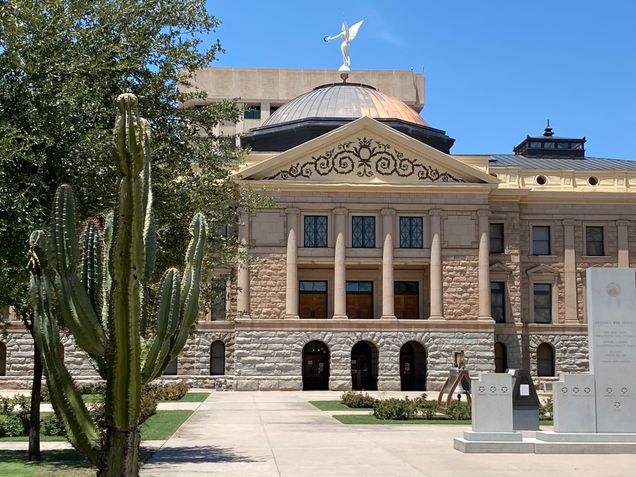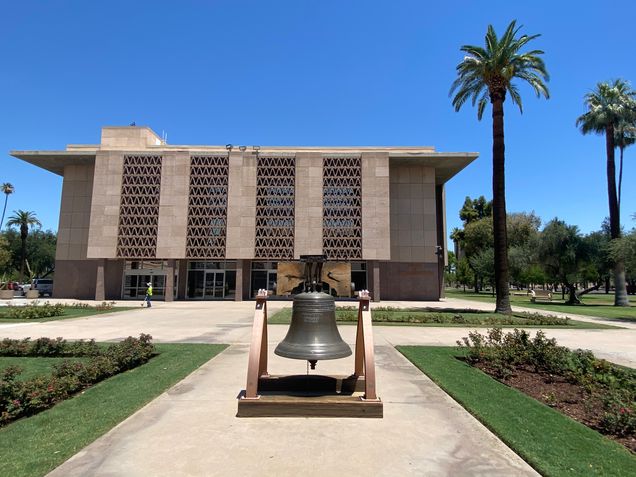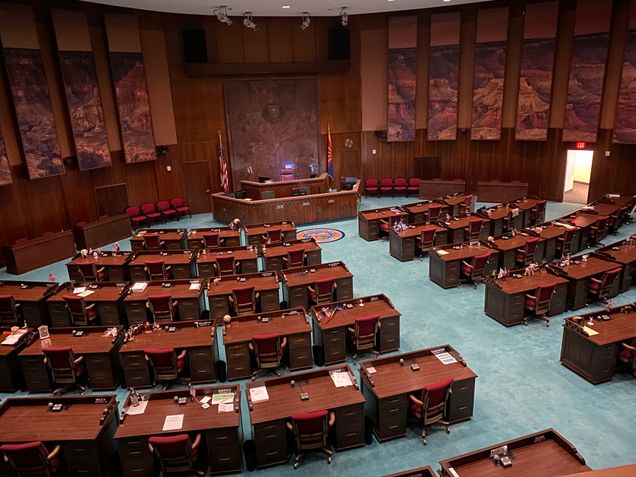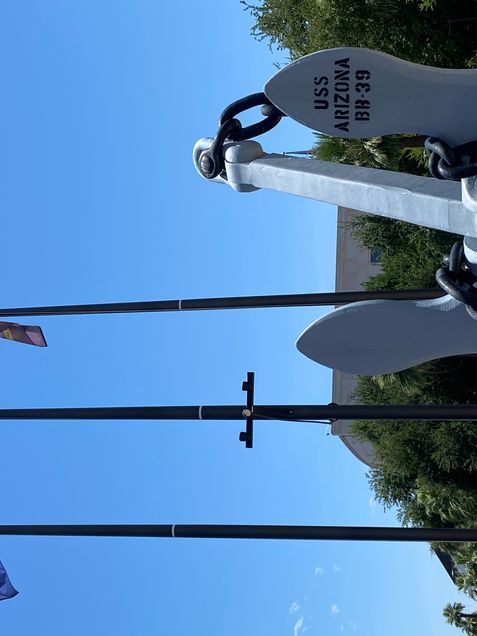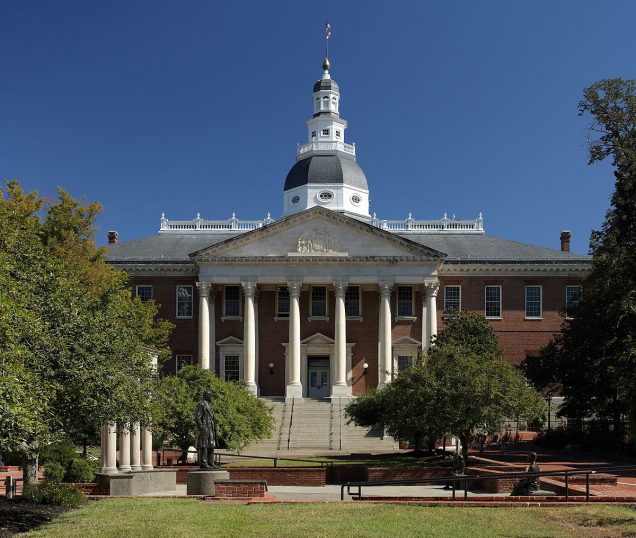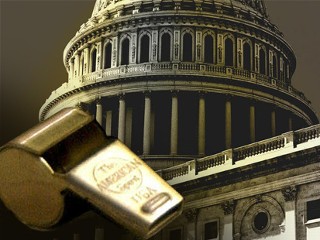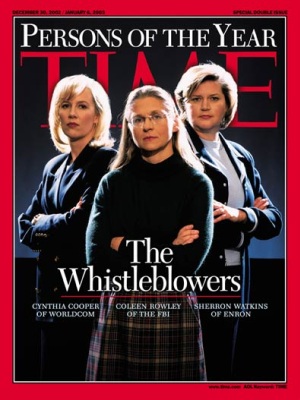Category: Uncategorized
A Visit to the Arizona Legislature
This summer vacation brought me to Phoenix Arizona. Not quite our usual family trip to the beach, but we are attending the Irish Step Dancing National Championships. While my daughters practiced, I had a chance to visit the Arizona Legislature (kind of).
Unfortunately, the old Capitol Building, which now houses the Arizona Capitol Museum was still closed due to Covid-19 restrictions. It is an impressive building with a copper dome (copper mining has been a huge part of Arizona’s history) and the Winged Victory statue on top.
Purchased for $150, Winged Victory changes direction with the wind—a feature drunk cowboys would take advantage of for fun. After drinking in one of Phoenix’s saloons, the cowboys apparently would try to make Winged Victory spin by shooting it with their revolvers.
The House and the Senate are in separate 1960s-era concrete buildings on either side of the old building.
I had a chance to see the House chamber with its decorative panels of the Grand Canyon.
The House also had a sculpture of its longest serving member, Edwynne Culter “Polly” Rosenbaum (1899-2003).
Rep. Rosenbaum (D-Globe) started her legislative career in 1949 when her husband Rep. William “Rosey” Rosenbaum passed away and she was appointed to fill the rest of the term. She served for the next 45 years until 1994–an incredible record that will never be beaten unless Arizona’s 8 year legislative term limits are repealed.
The House staff was welcoming—especially Steven at the front desk who was very knowledgeable.
Unfortunately, I could not get into the Senate chamber. Apparently, Senate President Karen Fann (R-Chino Valley) still has not lifted her Covid-related closure of the building. Perhaps this will happen after her “audit” of the 2020 Presidential election in Maricopa County is finished. In a funny moment, I asked several staff members in the House Building where the Senate’s audit was taking place. One said the ballots were now in Montana; yet another said the ballots were in Florida; one staffer said he thought the audit was finished. It’s really hard to believe this process has been called into question!
The mall in front of the government building had several touching memorials: There is a statute honoring the Navajo Code Talkers who were so key to victory during World War II,
the anchor from the USS Arizona,
the Bill of Rights carved into large standing stones,
and a life-sized statue of a family with one parent handing the other a baby.
This statue, titled “El Pasaje” is a tribute to the workers of Arizona, who have been injured while working. This is an especially poignant memorial given the recent political battles over immigration.
Although it was too bad I could not see everything I wanted to, it was still worth the trip.
Making Big Tech Pay Their Share: The Taxation of Digital Advertising in Maryland
In sharp contrast to the bevy of tax incentives offered to Amazon as part of a bid for the so-called “HQ2,” Maryland has charted a path towards taxation of technology companies as part of its commitment and obligation to its residents. This move to hold large companies accountable for the money they derive from Maryland residents is laudable, given the amount of data mined from individuals and used to sell targeted digital advertising as well as the crisis of state budget shortages. However, as written, Maryland’s efforts raise serious legal concerns that jeopardize the viability of the current iteration of the bill. The bill draws on an existing model to achieve important social goals. However, in the context of the American legal framework, the current iteration of the bill raises First Amendment freedom of speech concerns and faces further challenges under the commerce clause and federal legislation enacted to promote and facilitate Internet commerce. These shortcomings need not be fatal, though. With modest redrafting, the policy underlying the bill could be implemented in order to fulfill Maryland’s goals.
The bill
Introduced in the Senate as Senate Bill 2 and in the House as House Bill 695, parallel bills in the Maryland legislature impose a
tax on gross revenues derived from digital advertising. The amount ranges from 2.5% for a corporation with annual gross revenues from $100 million to $1 billion up to 10% for those with gross revenues over $15 billion. The revenue raised will go to the Blueprint for Maryland’s Future Fund, which funds K-12 education improvements in the state. This policy, though lauded as the first attempt to tax digital advertising revenues in the United States, is not without global precedent. Rather, it is modeled after a French law, which levies a 3% tax on digital interface and “targeted advertising services” in France. The tax only applies to companies with global revenues from digital interface and targeted advertising of more than €750 million globally, with at least €25 million of which was derived from French users. France enacted this legislation July 11, 2019, and was quickly rebuked by the American business community. In particular, President Trump threatened countermeasures of tariffs up to 100% on $2.4 billion worth of French imports to the United States, including sparkling wine and cheese. As a result, France and the U.S. negotiated a pause on the enactment of the law on the condition that the threatened tariffs not go into place.
Like its French model, Maryland’s bill specifically targets large technology companies. The Fiscal and Policy Note for the Maryland bill calls out by name Alphabet (the parent company of Google), Facebook, and Amazon. Proponents suggest that this legislation will force tech companies to “pay their fair share” by contributing to local tax bases rather than reaping the benefits while paying only minimal tax obligations. However, the opponents are not without their own ammunition. As part of their strategy to defeat the underlying policy, they raise legal questions regarding the current drafting and scope of the bill.
Legal considerations
Opponents argue that the selective taxation represents a content-based restriction on free speech because it selectively targets some kinds of advertising based on its communicative content. Following the recent Supreme Court case of Reed v. Town of Gilbert, which expanded the category of what is considered a content-based restriction on speech, this kind of selective taxation could be viewed as falling into the category of speech subject to strict scrutiny and therefore unlikely to survive judicial review. Even as an exercise of commercial speech, subject only to intermediate scrutiny under Central Hudson Gas & Electric v. Public Service Commission, such a tax is unlikely to be sustained. Restrictions on commercial speech must be no broader than necessary to directly further a substantial government interest. Under these circumstances, improving K-12 education is likely a substantial government interest, but the program could not be considered narrowly tailored. There are other means of raising the necessary revenue without burdening commercial speech of only large technology companies.
 Maryland’s tax also raises other, non-First Amendment concerns. As written, the bill could be construed as a violation of the commerce clause of the Constitution, because it would create the possibility of double taxation of the same single economic activity if every state were to adopt a similar regime, violating the “internal consistency” test. A final source of legal concern for the policy is the Permanent Internet Tax Freedom Act, or PITFA. PITFA prohibits state taxation of internet access as well as discrimination against online commerce. The taxation of digital advertising, but not traditional forms of advertising, could be seen as a discrimination against online commerce in violation of PITFA.
Maryland’s tax also raises other, non-First Amendment concerns. As written, the bill could be construed as a violation of the commerce clause of the Constitution, because it would create the possibility of double taxation of the same single economic activity if every state were to adopt a similar regime, violating the “internal consistency” test. A final source of legal concern for the policy is the Permanent Internet Tax Freedom Act, or PITFA. PITFA prohibits state taxation of internet access as well as discrimination against online commerce. The taxation of digital advertising, but not traditional forms of advertising, could be seen as a discrimination against online commerce in violation of PITFA.
Looking forward
The French example and advertising industry outcry against the Maryland proposal suggest that taxation of digital advertising will be a difficult prize to win. Significant political, economic, and legal hurdles remain. However, in an era of declining state revenues and K-12 funding crises, novel solutions must be sought. The digital advertising industry, reaping incredible profits, represents a tempting source of revenue for states dealing with these demands. However, as constructed, the policy presents serious legal shortfalls. This is not to say that the taxation of a major economic activity ought to be abandoned as a policy proposal. Rather, the specific construction of the statute needs to be reconsidered as the Maryland legislature moves forward. For example, a modification in the way that “in the state” is determined for the purposes of the tax could eliminate the concern of double taxation and, therefore, the commerce clause concerns. Where modest redrafting could save the policy from its legal challenges, it seems imperative to do so given the high stakes underpinning the policy.
 Jordan Neubauer anticipates graduating from Boston University School of Law in May 2020.
Jordan Neubauer anticipates graduating from Boston University School of Law in May 2020.
Drive-By Legislation Will Not Solve Drive-By Lawsuits
If you ask disability rights activists about the ADA Education and Reform Act of 2017 (the “Reform Act”), you may get a response that the Reform Act, which recently passed the House, is not nearly as benign or as amicable to the interests of persons with disabilities as its title suggests. In fact, many activists claim that the Reform Act would be downright harmful to persons with disabilities.
Tension over the Reform Act arises over key provisions requiring individuals with disabilities to give notice to businesses before filing a noncompliance lawsuit under the Americans with Disabilities Act (“ADA”). Currently, an individual can bring a lawsuit under Title III of the ADA immediately for a business’ failure to comply with the ADA. Under the proposed law, after receiving notice, the business would have 60 days to provide a written plan describing how the business will conform to the ADA’s requirements. The business then could take another 120 days to remove or make “substantial progress” toward removing the accessibility barrier. Individuals with disabilities would have to wait at least 180 days, if not longer, to enforce their civil rights under the ADA.
Although disability rights activists and many supporters of the disabled community oppose the proposed law, the Reform Act has some bipartisan support in Congress in an effort to stem the tide of excessive “drive-by” lawsuits.
Do we have a “Drive By” Lawsuit Problem in the United States?
“Drive-by” lawsuits are a practice where unscrupulous attorneys file hundreds of lawsuits alleging often minor, technical violations of the ADA. Lawyers working with as little as one plaintiff file lawsuits with boilerplate complaints looking for quick settlement payouts. These lawyers have often only visited the business they are suing one time and sometimes neither the lawyers nor their clients are patrons of the business.
Recent, more extreme versions of “drive-by” lawsuits are called “Google lawsuits;” where lawyers file lawsuits just by looking for ADA violations on Google Earth. By some estimates, businesses pay an average of $16,000 to settle these lawsuits rather than paying significantly more in legal fees to challenge the lawsuits in court. Under Title III of the ADA, a plaintiff cannot recover damages, but can recover attorneys’ fees along with injunctive relief (see p.378). Proponents of the Reform Act argue that these remedies promote excessive litigation.
Unfortunately, these “drive-by” lawsuits often do not result in increased ADA compliance. These settlements are often just shakedowns for cash, which may not actually lead to fixing the underlying ADA violation. As a result, some in the disabled community feel that these “drive-by” lawsuits actually harm relations between businesses and persons with disabilities. Still, could the Reform Act do more harm than good?
Could the ADA Education and Reform Act Damage the ADA?
Originally enacted in 1990, the ADA has improved the lives of countless individuals with disabilities. The ADA passed with widespread bipartisan support and is considered one of the most comprehensive and progressive disability civil rights statutes in the world. In fact, many other nations have modeled their disability rights laws after the ADA.
The ADA is effective, in part, because of two key areas: Title I and Title III, which allow private rights of action to enforce individual rights. Title I protects persons with disabilities in the employment context, and Title III protects persons in public accommodations. Under Title III, places of public accommodation must remove accessibility barriers, but only if this is “readily achievable” and not and where removing barriers would require a fundamental alteration or an undue burden. Unfortunately, although employers and places of public accommodation must proactively comply with the ADA, persons with disabilities often have to bring lawsuits to enforce the provisions of the ADA. Businesses comply with the ADA not only because it is the right thing to do, but also because of the threat of lawsuits.
Accordingly, disability rights activists decry the Reform Act as a thinly veiled threat to disability rights. The proposed law would fundamentally shift the balance of power for ensuring compliance to favor businesses. Instead of proactive compliance, businesses could sit on their hands and wait to be sued. Then, businesses would only have to show “substantial progress” toward compliance, not even full compliance, over the course of months. For those who are legitimate patrons of a business and who require accessibility, waiting six months or more for “substantial compliance” is simply not a realistic option.
A Path Forward: Changing Our Perception
Disability rights attorney Robyn Powell argues changes can be made without the Reform Act. First, Ms. Powell posits that attorneys are bound not to represent individuals in frivolous lawsuits; making this is an issue for state courts and bar associations to address, not Congress. Second, Ms. Powell points out that the, “ADA does not require any action that would cause an ‘undue burden’ or that is not ‘readily achievable,’” for a business to accomplish.
Many of the issues that the Reform Act seeks to address are issues that can be resolved without curtailing the civil rights of persons with disabilities. Both the business community and the disability community have mutual interests in ensuring that frivolous, “drive-by” lawsuits are prevented. However, rather than place severe restrictions on the rights of persons with disabilities through an extensive period of notice and opportunity to cure, other options should be considered.
States and their respective state bar associations could opt to impose stricter penalties for attorneys filing frivolous lawsuits under the ADA. Coupled with these stricter penalties, state bar associations could also adopt mechanisms like thresholds for the number of lawsuits that can be filed with one plaintiff under the ADA before an investigation is triggered. Alternatively, we could adopt requirements that prioritize injunctive relief over attorney’s fees or damages. Such requirements would force parties to engage with each other and would reduce the number of businesses that can be subject to “drive-by” lawsuits. Further, injunctive relief under the ADA would be consistent with the goals of truly achieving accessibility. At the very least, if the Reform Act moves forward, it should be amended so that the notice and opportunity to cure period is significantly shorter in order to lessen the burden that would be shifted to persons with disabilities.
Finally, when it comes to accessibility we would all do well to remember that accessibility is a universal issue, not just a disability issue. For example, stairs are an accommodation to people who are capable of walking to move between floors. Despite the frustration of these “drive-by” lawsuits, the fact that these lawsuits exist serve as a reminder that we must continue the push for improving accessibility for all people. With increased accessibility, there will be less opportunity to take unfair advantage of laws like the ADA.
 Nicholas Stone graduated from Boston University School of Law in May 2018. He plans to practice in Portland Oregon.
Nicholas Stone graduated from Boston University School of Law in May 2018. He plans to practice in Portland Oregon.
WHO LET THE DOGS OUT? CALIFORNIA BANS USE OF PUPPY MILL
In October 2017, California became the first state to pass a law to deter the use of puppy mills by potential puppy buyers. Under the new law, pet stores must work with animal shelters and other rescue operations to obtain dogs, cats and rabbits, and are prohibited from using breeders. However, private and individual customers can still use puppy mills, and nothing in the act adds direct regulations on domestic animal breeders in the state.
 Over the past several years, there has been a nationwide conversation among pet lovers about the ethics of puppy mills. At the center of the debate is the competition for owners between adoption/rescue groups, and breeders. According to the American Pet Products Association (APPA), 34% of currently owned dogs were raised by a breeder, as opposed to 23% coming from an animal shelter or other humane rescue group. Origination data is not entirely clear however, as the American Humane Association (AHA) and the American Veterinarian Medical Association (AVMA) put breeder-acquired ownership figures at less than 20%. Shelter-based ownership figures vary even more, with the AVMA putting the adoption population at 84.7% and the AHA estimating a 22% adoption population. Available figures for breeder-acquired cats are below 5%. While it is difficult to claim that adoption and rescue agencies are at a disadvantage for owners strictly because of breeder competition, the sheer number of pets in shelters (5-8 million dogs and cats) and getting euthanized every year (3-4 million dogs and cats), makes many wonder why people use breeders at all. Proponents of laws like California's believe that people who buy breeder-bred animals could have instead adopted an animal from a shelter.
Over the past several years, there has been a nationwide conversation among pet lovers about the ethics of puppy mills. At the center of the debate is the competition for owners between adoption/rescue groups, and breeders. According to the American Pet Products Association (APPA), 34% of currently owned dogs were raised by a breeder, as opposed to 23% coming from an animal shelter or other humane rescue group. Origination data is not entirely clear however, as the American Humane Association (AHA) and the American Veterinarian Medical Association (AVMA) put breeder-acquired ownership figures at less than 20%. Shelter-based ownership figures vary even more, with the AVMA putting the adoption population at 84.7% and the AHA estimating a 22% adoption population. Available figures for breeder-acquired cats are below 5%. While it is difficult to claim that adoption and rescue agencies are at a disadvantage for owners strictly because of breeder competition, the sheer number of pets in shelters (5-8 million dogs and cats) and getting euthanized every year (3-4 million dogs and cats), makes many wonder why people use breeders at all. Proponents of laws like California's believe that people who buy breeder-bred animals could have instead adopted an animal from a shelter.
Another facet of the “puppy mill” debate is the living conditions in breeder facilites. Claims of animal cruelty plague the reputation of breeder businesses. Though breeder operations are governed by Federal USDA regulations and inspections, irresponsible breeders can evade these oversights and sell animals that have been bred improperly, leading to pets with physical and psychological ailments. Many times, these irresponsible breeders will focus on quantity, instead of quality of the animals (hence the term “mills”) possibly leading to poor health, abandonment, or even death of the animals. Since these disreputable breeders often sell to pet stores, instead of directly to screened buyers, laws like the one California just passed will likely serve as a significant deterrent for negligent breeders. However, some detractors of the bill say many cities statewide (including LA, San Diego, and San Francisco) already ban “mass breeding” and other unhealthy practices, so this new law is more likely to constrain the breeders who do not engage in these poor practices, yet sell to pet stores, than the irresponsible breeders.
Aside from animal welfare, steering potential pet owners and pet shops to animal shelters should benefit the state’s taxpayers. Publically run animal shelters cost the state approximately $300 million a year. If this law has its intended effects and decreases overcrowding in animal shelters, the state can accordingly decrease spending on housing, feeding, and servicing shelter animals. While California may pinch some pennies with decreased animal shelter populations, the breeding community may suffer economically under this bill. California has roughly 800 active breeders selling animals in the state. Even if only a small percentage are fully reliant on pet stores for income, that is still dozens of California’s workers being effectively forced out of a job under this law. However, some of this job loss may be offset by impacted breeders selling to out-of-state pet stores who do not have similar laws.
Though California’s new law was a key win for anti-puppy mill and animal welfare advocates, there are still some detractors. For example, this law may present challenges to those seeking specific breeds for their pet. Consumers may no longer easily get breed specific animals in pet stores, and specific breeds may become more costly. This might be particularly cumbersome for someone looking for a service animal of a particular breed best suited to help manage a condition. The American Kennel Club released a statement saying the law “not only interferes with individual freedoms, it also increases the likelihood that a person will obtain a pet that is not a good match for their lifestyle and the likelihood that that animal will end up in a shelter.” Further, this legislation may have the unintended consequence of increasing animal deaths and abandonment at puppy mills, because the mills no longer have access to their main customers. If the mills have not sold off all their animals by the 2019 effective date of this law, the animals may have nowhere to go. Breeders whose business is hurt as a consequence of this law may spend even less money on the care of the animals, or be forced to surrender the animals to a shelter. But given the delayed effective date of the law and the continued legality of breeder use by individual parties, the foreseeable issues will likely be negligible in light of the positive changes.
Since California passed this law, a Massachusetts lawmaker has also proposed a similar bill that would deter the practice of commercial breeding. Though California is the first state to pass this kind of prohibition, cities all over the country have been passing similar ordinances, so it is likely that states will follow suit if California’s law works as intended.
 Andrea Ogechi-Okoro anticipates graduating from Boston University School of Law in May 2018.
Andrea Ogechi-Okoro anticipates graduating from Boston University School of Law in May 2018.
Inter Partes Review: non-Article III Adjudication of Private Property Rights
In November 2017, the Supreme Court heard oral arguments for Oil States Energy Services, LLC v. Greene’s Energy Group. Oil States poses a question that forces the Supreme Court to consider whether it will turn patent strategy on its head: whether inter partes reviews (IPRs) violate the Constitution by extinguishing private property rights through a non-Article III forum without a jury. The Federal Circuit is notoriously the appellate circuit most reversed by the Supreme Court – by May 2017, the Court had reversed 25 of the 30 cases it accepted from the Federal Circuit. Will Oil States suffer the same fate?
An IPR, established as one of the cornerstones of the American Invents Acts (AIA) in 2011 and initiated in 2012, is a proceeding instituted by the U.S. Patent and Trademark Office (USPTO), upon petition by an outside party, allowing parties to challenge the validity of an issued patent before the Patent Trial and Appeals Board (PTAB), a non-Article III tribunal. Congress created IPRs primarily to increase the efficiency of an otherwise expensive and time consuming traditional patent validity challenge in court. While traditional patent litigation may consume millions of dollars and years of the parties’ time – a waste of financial and judicial resources and creating uncertainty within the field of technology encompassed by the patent – an IPR typically costs the parties a comparatively small six figure sum and the AIA requires the PTAB to issue a final written decision within one year of IPR institution.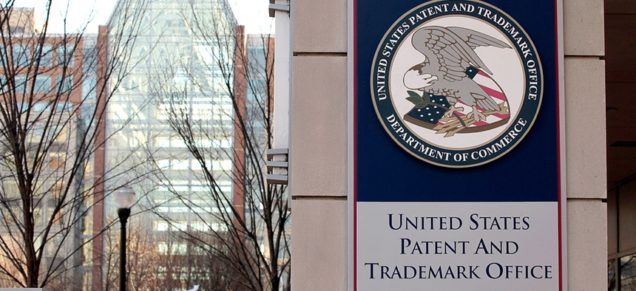
Since 2012, IPRs have become a popular mechanism for parties to challenge the validity of patents – in part due to their efficiency and in part because the PTAB does not begin with a presumption of validity, whereas courts do. In effect, the PTAB has invalidated all claims of the challenged patent in over 1,200 proceedings, roughly 74% of all IPRs. Only 13% of IPRs result in no claims of a patent being invalidated.
The courts have already disposed of numerous challenges to the constitutionality of patent validity review procedures conducted before the USPTO. Before the AIA introduced IPRs, the USPTO had already been invalidating patents since 1981 via ex-parte reexamination. The Federal Circuit has repeatedly affirmed the constitutionality of the USPTO’s authority in such proceedings, stating that “[a] defectively examined and therefore erroneously granted patent must yield to the reasonable Congressional purpose of facilitating the correction of governmental mistakes.” Patlex Corp. v. Mossinghoff, 758 F.2d 594, 604 (Fed. Cir. 1985). The Federal Circuit has more recently denied a similar constitutional challenge to IPRs, stating that patent rights are public rights, reviewable by an administrative agency, and therefore assigning review of patent validity to the USPTO is consistent with Article III. MCM Portfolio LLC v. Hewlett-Packard Co., 812 F.3d 1284, 1291 (Fed. Cir. 2015).
Oil States challenged IPRs alleging a violation of both Article III and the Seventh Amendment. Concerning Article III, Oil States argued that it is unconstitutional for a non-Article III court / Article I tribunal to adjudicate private property. Oil States argued that the Seventh Amendment guarantees patent owners the right to a jury trial because historically, patent infringement cases have been heard in courts of law in England before juries.
Oil States argued that the Supreme Court has once before reviewed and disavowed USPTO patent validity review procedures (otherwise, the Court has only denied certiorari in the past to review Federal Circuit decisions treating the question, including the two above decisions) and the differences in the statutorily created IPR and ex parte reexamination.
In 1898, the Supreme Court held that “the Patent Office has no power to revoke, cancel, or annul” an issued patent. McCormick Harvesting Mach. Co. v. Aultman & Co., 169 U.S. 606 (1898). However, this case did not concern the constitutionality of such proceedings, and it is likely that the Court will limit McCormick to the narrow position that the USPTO does not exercise jurisdiction over an issued patent in the absence of authorization from Congress, as was lacking in 1898. Now that Congress has expressly authorized such review via the AIA, the Court will likely find such review constitutional.
Oil States highlights the differences between AIA-created IPRs and ex parte reexaminations; IPRs are adversarial proceedings including discovery, briefings, hearings, and a final judgment, whereas ex parte reexaminations are more akin to interactive proceedings between the agency and patent owner.
To resolve this case, the Court will likely stay away from disclaiming the statutory distinctions establishing IPRs as trial-like proceedings, because these hold some legitimacy, and focus on whether a patent is a public or private right. If a patent is a public right, then there is no issue with IPRs being trial-like proceedings conducted before non-Article III adjudicators because it is proper for an agency to adjudicate a public regulatory scheme. If, on the other hand, patents are private rights, as Oil States contends, then the Court would be forced to either disavow IPRs or distinguish their characteristics from a trial. The Federal Circuit provided the Court with a mirror distinguishing IPRs from traditional trials, but this distinction is fragile at best. Ultratec, Inc. v. Captioncall, LLC, 2017 WL 3687453, *1 n.2 (Fed. Cir. Aug. 28, 2017). The Court would find more stable grounding classifying patents as quintessential public rights, conferred only by virtue of a statute.
The most curious note regarding the Supreme Court’s decision to hear Oil States is that it concurrently agreed to hear SAS Institute v. Lee, which asks the Court to consider whether the AIA permits the USPTO to select claims from a petition and partially institute an IPR or whether the USPTO must wholly grant or deny a petition, either blessing or damning all claims. If the Court intends to destabilize the AIA and declare IPRs unconstitutional, why consider the USPTO’s duty to the petitioner for an IPR in the same term? It is likely that the Supreme Court will uphold the constitutionality of the AIA’s grant of authority to the USPTO and permit IPRs to continue, but will use these two cases as an opportunity to either limit the scope and effect of IPRs or force clarity regarding the deficiencies of IPRs – such as lacking judicial rules of ethical conduct, improper handling of evidence, improper handling of amendments, or simply disregarding established standards in favor of PTAB-created standards.
Eric Dunbar anticipates graduating Boston University School of Law in May 2018.
Continuing Responses to 9/11: The Price of Justice
On September 28th, 2016 Congress voted in favor of the first veto override during Obama’s presidency. The bill at issue was the Justice Against Sponsors of Terrorism Act (JASTA), a very controversial piece of legislation that received massive support in both the House and Senate but was adamantly opposed to by the Administration. Prior to JASTA becoming law, victims of terror attacks and their families could only bring suit against a foreign nation if the U.S. Department of State had designated that nation as a state sponsor of terrorism and the specific attack was aided by the government. Currently, there are only three nations subject to lawsuits as state sponsors of terrorism: Iran, Sudan, and Syria. JASTA severely limits the scope of sovereign immunity and expands the liability of foreign nations for terrorist attacks.
 Under JASTA, United States federal courts will now have jurisdiction over civil matters that are brought by United States citizens against foreign nations for claims of injury to person or property that occur inside of the United States as a result of either (1) an intentional act of terrorism or (2) a tortious act by a foreign state, or any official of that foreign state while acting within the scope of his or her office regardless of where the act occurred. The bill also imposes liability on any person who conspires to commit or knowingly aids and abets an act of international terrorism committed by a designated terrorist organization. While JASTA does authorize the Department of Justice to grant a stay if the United States is engaged in good-faith discussions with the foreign nation to resolve the claims, former President Obama was concerned by the serious potential consequences of the bill.
Under JASTA, United States federal courts will now have jurisdiction over civil matters that are brought by United States citizens against foreign nations for claims of injury to person or property that occur inside of the United States as a result of either (1) an intentional act of terrorism or (2) a tortious act by a foreign state, or any official of that foreign state while acting within the scope of his or her office regardless of where the act occurred. The bill also imposes liability on any person who conspires to commit or knowingly aids and abets an act of international terrorism committed by a designated terrorist organization. While JASTA does authorize the Department of Justice to grant a stay if the United States is engaged in good-faith discussions with the foreign nation to resolve the claims, former President Obama was concerned by the serious potential consequences of the bill.
The first of these concerns was that such a bill will reduce the effectiveness of a United States response to an indication that a foreign state has supported acts of terrorism. Litigation brought under this act will effectively remove the matter from the hands of national security and foreign policy professionals and place these consequential foreign affairs decisions in the hands of private litigants. In these matters, the President is meant to be the sole representative of the United States to give a strong unified voice for the nation. If a foreign state acted in a way so as to provide support to terrorist organizations which were harming United States citizens, then a unified response by the United States designating that nation as a state sponsor of terrorism would be warranted and would carry many more consequences than being sued under this new law.
The most obvious effect of JASTA, and the driving force behind the creation of this legislation, is to allow the victims of the September 11th attacks to bring suit against the government of Saudi Arabia, a country that some believe supported the terrorist organization responsible. The reason for this belief stems from the fact that fifteen of the nineteen September 11th hijackers were Saudi citizens, although neither the 9/11 Commission Report or the 2014 FBI Report on the Commission and new findings found any connection to the government of Saudi Arabia. The United States has an ongoing relationship with the Kingdom and the revocation of sovereign immunity will result in strained and potentially hostile relations in the future. Before the bill was passed, the foreign minister of Saudi Arabia, Adel al-Jubeir, warned that if JASTA was passed, the Kingdom would sell off approximately $750 billion held in United States treasury securities and other assets to avoid having it seized by American courts. Such an action could have drastic destabilizing effects in the global financial market but could also be equally as detrimental to Saudi Arabia. For this reason, it is unlikely that they will follow through with this threat since continued cooperation is needed by both nations. Some scholars believe that a more probable act of retaliation will come in the counterterrorism field, opening Americans up to greater physical danger.
The second concern raised by former President Obama was the high likelihood of reciprocal laws being enacted by other nations. The United States is the largest beneficiary of sovereign immunity since it has a greater international presence than any other nation. Revoking the sovereign immunity of other countries will undoubtedly lead to similar actions by foreign nations toward the United States, subjecting the nation to foreign court proceedings. The end of internationally recognized and respected sovereign immunity in these cases will result in suits against the United States which could lead to government assets being seized abroad, a particularly attractive idea for foreign nations given the United States’s financial backing. This concern was somewhat validated when French Parliament member, Pierre Lellouche, said that he would pursue legislation allowing French citizens to bring lawsuits against the United States for cause after the passage of JASTA.
The third concern raised was the potential for complicating the United States’ relationships with one of our closest of allies. Allowing litigation by United States citizens to be brought against our allied nations could enable wide-ranging discovery demands, which could lead to a breakdown in the amount of cooperation the United States receives in the future. A very possible response is the foreign nation limiting their cooperation on national security issues at a time when the United States needs to be building and strengthening alliances more than ever.
Just two days after JASTA became law, the first lawsuit was filed in Washington D.C. Stephanie Ross DeSimone alleged that the Saudi Arabian government provided material support to al Qaida and its leader, Osama bin Laden, resulting in the September 11th terrorist attack that killed her husband. In addition to Ms. DeSimone, the new law will allow approximately 9,000 potential plaintiffs to sue Saudi Arabia for injuries related to the terrorist attacks of September 11th, 2001.
While the House and Senate approved this bill with a large majority, a fact that former President Obama believed resulted from a desire not to vote against a 9/11 bill so soon before an election, several members of Congress have already begun to voice concern about the unintended consequences of the legislation. While no firm plans have been laid down, there has been talk in Congress of the need for further discussion on the matter and potential amendments to the new bill to address some of the newly recognized potential consequences. With the prevalence of terror attacks in today’s society and the speed with which lawsuits are being filed, there is no doubt that if Congress hopes to prevent any of the unintended consequences from being realized they must act quickly.
The unintended consequences of this bill began to arise almost immediately. Anti-Israel activists have already begun using JASTA to sue the Israeli government, claiming that it has committed war crimes, genocide, and ethnic cleansing against Arabs living in the West Bank. The complaint argues that “[b]y promoting, participating in, or funding international terrorism, all defendants have also violated the recently enacted statute known as Justice Against Sponsors of Terrorist Act.” Several individuals recently appointed to President Trump’s administration are singled out by these claims. The complaint alleges that David Friedman, a lawyer chosen by President Trump as U.S. ambassador to Israel, sends $2.2 million to settlers of Bet El every year and has funded Israeli settlements since 1977. Friedman is also president of American Friends of Bet El Institutions, a co-defendant in this action. The Kushner Family Foundation is yet another defendant with close ties to the Trump administration that is claimed to have violated federal law. This claim is merely the beginning of similar actions taken against foreign nations under the broad scope of JASTA.
There have been some reports that Saudi Arabia was using an intermediary named Qorvis to deceive United States veterans and convince them to lobby for an amendment to JASTA that would limit the scope of liability to those nations that “knowingly” support terrorist organizations. These claims have spread through many lesser known news sources but remain unsubstantiated and have gone unmentioned among mainstream media. It does not appear that Saudi Arabia has taken any action in response to the passing of JASTA at this point despite the numerous threats.
The Wall Street Journal reported last March that Saudi Arabia’s energy minister Khalid al-Falih said his government was “not happy” about the law, but believes that after “due consideration by the new Congress and the new administration, that corrective measures will be taken.” Whether the Trump Administration will have more influence over Congress than the Obama Administration on this issue is a significant foreign policy question.
 Alexandra Raymond is from Vergennes, Vermont and graduated from New York University in 2014 with a B.A. in Sociology and Law & Society. She is expected to earn her Juris Doctor from Boston University School of Law in 2018. Alexandra will be working for an investment management firm in Boston during the summer of 2017 and will then spend her next semester studying international law at Leiden Law School in the Netherlands. Upon graduation, Alexandra hopes to pursue a career that allows her to explore her interests in business, social justice, and international law.
Alexandra Raymond is from Vergennes, Vermont and graduated from New York University in 2014 with a B.A. in Sociology and Law & Society. She is expected to earn her Juris Doctor from Boston University School of Law in 2018. Alexandra will be working for an investment management firm in Boston during the summer of 2017 and will then spend her next semester studying international law at Leiden Law School in the Netherlands. Upon graduation, Alexandra hopes to pursue a career that allows her to explore her interests in business, social justice, and international law.
When the shoe doesn’t quite fit: Fitting a digital world into an analog statutory structure
Few issues in recent years have bedeviled lawmakers at the state and local level as much as the question of how to react to the online “sharing” economy, where people with a car they don’t use much or a typically empty spare bedroom decide to monetize their asset. When voters in Austin, Texas decided to require Uber and Lyft drivers to submit to mandatory fingerprint background checks, those two companies simply closed down their operations in the city. The overall picture for ridesharing and homesharing laws is, to be blunt, a mess. For the time being, flying under the radar would seem the safest course for the industry, since most jurisdictions still don’t regulate them at all.
These crosscurrents make the homesharing site Airbnb’s decision to approach the city of Washington, DC and offer to collect and remit taxes all the more curious. Even more interesting is that the District hasn’t bothered as yet to amend its laws regarding transient accommodations, meaning the entire industry continues to operate in a legal grey area in the city. Is this actually the company striving to be a good corporate citizen, as they claim? Is this a savvy move on the company’s part to insulate itself within regulatory opening? Or is it nothing more than regularized bribe for the city not to focus regulatory scrutiny on the company’s operations?
As much as one might think Airbnb’s decision to pay taxes was a tax issue, the tax laws turn out to be something of a red herring. The District of Columbia’s official code imposes a 4.45% excise tax on all temporary lodging, defining that term as “any hotel, inn, tourist camp, tourist cabin, or any other place in which rooms, lodgings, or accommodations are regularly furnished to transients.” Plainly if Airbnb fits anywhere in this statute, it falls under the “any other place” catchall.
Although Airbnb itself directs potential hosts to the taxing provisions, the more interesting questions here arise on the regulatory side, or, more precisely, the zoning side. Washington’s official code delegates detailed zoning regulations to a special Zoning Commission, charged with regulating a plethora of facets of the cityscape. The Zoning Commission in turn prescribes regulations for the permissible use land in the city. Use of a property as a Hotel, Inn or Motel, Bed and Breakfast, Boarding House, or Rooming House each triggers separate requirements. For example, a Hotel license requires just three rooms, but no parking spaces, while an Inn or Motel license requires 30 rooms with the availability of a parking space for each. Boarding House licenses and Rooming House licenses require the holder to offer at least five rooms in addition to meals, while a Bed and Breakfast license, while not having a minimum number of available rooms, apply to “guesthouses, housekeeping cabins and cottages, tourist homes and youth hostels.” Ultimately, none of these licenses seem appropriate for an Airbnb host since all of them require the applicant to register as either corporation or some other form of business and comply with a variety of city sanitary and fire codes.
Instead, potential hosts need a Home Occupation Permit, which allows the holder to conduct limited business or professional activities from a residentially zoned structure. Residential use regulations set out in detail what a Home Occupation Permit holder may and may not do on the premises. Even a cursory reading of these regulations reveals how their drafters intended them to apply: to (very) small-businesses or self-employed persons who operated their income producing activities from a small portion of their home or apartment.
One rule (11-203.4(b)) provides that only 25% of the premises may be used for the owner occupation; how is an Airbnb host supposed to enforce that? Draw lines on the floor or his or her apartment indicating the 25% of floor space a guest can use? Another subset of rules (11-203.6) limits the number and nature of retail sales on the property, while yet another (11-203.5) proscribes most types of outdoor signage. Section 11-203.8 of the regulations seems to offer some relief to potential hosts by providing that the owner may operate a Bed and Breakfast facility (and very kindly providing a dispensation from the floor area limitations mentioned earlier). Unfortunately, this exception does not apply to residences in a “multiple dwelling” (i.e. apartment buildings) and, more importantly, requires the owner to obtain a Bed and Breakfast license.
As things stand there appear to be three legal categories would-be hosts fall into. First, hosts who live in the place they’re renting and have fewer than two guests at a time must get a Home Occupation Permit and a Bed and Breakfast license. Second, hosts who live in the place they’re renting and have three or more guests at a time need special approval from the Zoning Commission and a Rooming or Boarding House license. Third, hosts who don’t live in the place they’re renting need a use variance from the city. The chart below lays out these categories. Hosts also need to remember that city laws don’t do anything to address separate apartment or condominium building rules.
Even the Washington, DC Department of Consumer and Regulatory Affairs (DCRA) admits this legal structure needs updating to reflect current practice. “The process was developed before the advent of services like Airbnb, so some updating to account for emerging business models may be warranted,” a DCRA spokesman conceded.
Given this regulatory patchwork, it seems clear that shoehorning the digital marketplace in transient accommodations into existing law is, at best, a half-hearted solution. Many hosts undoubtedly violate this legal framework, either deliberately or from sheer ignorance. With Airbnb paying taxes to the city, however, it seems unlikely that DC will crack down on violators. Condo boards and building management may be the only people properly incentivized to enforce the current law. And as our history repeatedly teaches us, any legal regime which turns large groups of citizens into scofflaws invites people to treat the rest of the laws with that much less respect.
 Matthew Kipnis, Boston University School of Law class of 2018
Matthew Kipnis, Boston University School of Law class of 2018
Closing Loopholes with New Whistlerblower Protection Legislation and Dispensing the View of Whistleblowers as Mere Disgruntled Employees
Following the havoc of corporate scandals caused by Enron, Worldcom, and Madoff and Stanford's Ponzi scheme, instances of corporate fraud and whistleblowing is no longer a novel subject matter today. Accordingly, questions surrounding the extent of ethical responsibility of those employees ancillary to the fraud emerged but with no clear answer. Blowing the whistle on one's own employer certainly appears to be a violation of loyalty and other fiduciary obligations, while on the other hand, whistleblowers serve an important function in enforcing corporate compliance. Retaliation often follows and whistleblowers are inevitably in need of legal protection. These two interests collide head on, leaving open a number of questions as to the nature of an employee's fiduciary duty, the policy rationales for protecting whistleblowers and the approach that the law must take. In the meantime, with the rise of litigation involving whistleblowers in recent years, there has been movement in Congress to enact a new statute that will further expand whistleblower protection and close loopholes in current legislation, particularly in the financial and banking industry.
Background of Whistleblower Legislation
Among others, Congress enacted three notable statutes to protect whistleblowers from retaliation: the Whistleblower Protection Act of 1989, the Sarbanes-Oxley Act, and the Securities and Exchange Commission's Dodd-Frank Wall Street Reform and Consumer Protection Act.
The Whistleblower Protection Act ("WPA") was enacted in 1989 by the 101st Congress which took the foundation laid by the Civil Service Reform Act of 1978 and expanded the provisions to increase protection for whistleblowers. The WPA forbids the federal government from reprisal against federal government employees for blowing the whistle and encourages employees to report wrongful conduct of federal government employers by means of monetary awards. The WPA remains the primary federal statute that guarantees federal employees whistleblower protection, although, under this statute private sector employees do not have standing for a cause of action.
The Sarbanes-Oxley Act ("SOX Act" or "the Act"), promulgated in 2002 in response to the Enron and WorldCom debacle, significantly expanded the scope of whistleblower protection and increased regulation of businesses in order to deter and detect fraud, particularly corporate and securities fraud. The statute reaches employees in the private sector, particularly those employed by publicly held companies. It was one of the "first set of comprehensive federal whistleblower provisions protecting employees who raise concerns about a violation of any federal criminal statute."
In spite of the enactment of the SOX Act, which was hailed at the time as one of the most comprehensive bodies of law enacted to deter and prevent corporate malfeasance, another series of corporate fraud mayhem, most notably the fifty billion dollar Ponzi scheme perpetrated by Madoff and Stanford, in addition to the 2008 financial crisis, caused Congress to pass the Dodd-Frank Wall Street Reform and Consumer Protection Act in 2010 ("Dodd-Frank Act" or the Act"). The purpose of the statute was clearly to deter corporate malfeasance as well as other illegal business practices. In the process, the Dodd-Frank Act broadened whistleblower protection even further beyond the bounds of the SOX Act by expanding whistleblower protection to beyond public companies and by increasing monetary incentives to report perpetration of fraud to government agencies.
Nonetheless, the Dodd-Frank Act is not without loopholes. Among others, the statute does not expressly provide for individual liability nor defines the term "employer." This leaves open an interpretation strongly suggesting inapplicability of the anti-retaliation provisions to individuals. It also leaves open the definition of "covered employee" who may be entitled to whistleblower protection, which makes room for arguments for varying interpretations and perhaps more litigation. Furthermore, the statute is silent regarding the enforceability of non-disclosure agreements that restrict the employees from disclosing confidential information or present employees with a waiver of their protected rights under whistleblower legislation. In practice, some companies have internally disciplined whistleblowers for communications with the government.
Latest Statistics
In practice, during the last decade, whistleblowing cases received have increased in significant numbers. In 2005, cases filed by complainants under various agencies and statutes including the Occupational Safety and Health Administration ("OSHA"), Sarbanes Oxley Act ("SOX"), and the Surface Transportation Assistance Act ("STAA") totaled 1934; by 2015, this number climbed to 3288. What is notable is that amongst the dramatic increase of complaints, the rates of positive outcomes have stayed relatively steady. Out of the total number of cases received in 2005, 20 percent counted for positive outcomes for complainants while 66 percent of cases were dismissed. In 2015, the positive outcome for complainants amounted 25 percent of all cases and 50 percent of total cases received were dismissed. It is also notable that despite a significant increase in the total number of cases received, the number of cases given merit have stayed roughly the same. Out of 1902 cases in 2005, 41 cases were given merit. However, in 2015, out of 3337 cases, only 45 cases were given merit. Most of the positively regarded outcomes were settled. Thus, generally, in enforcing the 22 whistleblower statutes, OSHA dismissed a fair number of cases received and a very small percentage of the claims have been given merit. It is apparent that in spite of the increased frequency of whistleblowing, complainants are still predominantly viewed as mere disgruntled employees that dispose their loyalty rather than those internally convicted to adhere to their personal ethical standards.
New Legislation
On February 25, 2016 Representative Cummings and Senator Baldwin submitted H.R. 4619 and S.2591 also known as Whistleblower Augmented Reward and Non-Retaliation (WARN) Act in order to "to provide heightened protections for those who blow the whistle on suspected financial misconduct." The sponsors of the bill said in a press release that the legislation is "to combat retaliation against whistleblowers and to close loopholes in the DoddFrank Act relied upon by Wall Street giants." The new statute will increase whistleblower protection by expanding whistleblower protections and providing additional legal procedures for such protections. The bill attempts to do this by prohibiting employers from "forcing whistleblowers to waive their rights or disclose their communications with the government; safeguard whistleblowers from retaliation if they refuse to participate in activities they believe to be in violation of the law"; harmonize whistleblower awards under the Dodd-Frank Act with other relevant statutes so that whistleblowers are "eligible to receive between 10 percent and 30 percent of penalties and recoveries"; apply additional "procedures, evidentiary standards, and burdens of proof" allowing whistleblower to show that their actions led to unfavorable personnel actions.
The WARN Act is endorsed by Americans for Financial Reform, the AFL-CIO and the Communication Workers of America, and other organizations. So far, there has been no notably strong opposition to the bill since it has been referred to the Subcommittee on Commodity Exchanges, Energy, and Credit. Although the bill proposes some changes that are rather drastic and thus proponents of the bill expect some opposition that may find the bill extremely employee-friendly, they believe this to be "good legislation" that will improve whistleblower protection.
Legislating a Disaster: Congressional and Tribal Responses to the Gold King Mine Spill
On August 5, the Animas River in La Plata County, Colorado suddenly turned a bright and unnatural shade of orange as an estimated three million gallons of toxic wastewater spilled from the abandoned Gold King Mine. Local, State, and Tribal governments scrambled to react as the wastewater brought a sudden spike in levels of arsenic, lead, and other dangerous metals. In response to the spill, access to the river has been closed indefinitely and three states (Colorado, New Mexico, and Utah) and two tribes (The Navajo Nation and the Southern Ute Tribe) have declared states of emergency. The wastewater spill—a result of heavy machinery usage near the mine—was ironically caused when Missouri-based EPA contractor Environmental Restoration LLC accidentally breached the mine during an attempted clean-up effort. The spill has not only caused a potentially devastating environmental impact, and put strain on already limited water resources, but also stands to curb tourism, one of the area’s largest economic sectors after the closure of the area’s once profitable mines. Acting to address the crisis, bills have been filed in the House and the Senate, which seek to hold the EPA responsible for costs and harm related to the spill. Additionally, Navajo Councilman Jonathan Hale has filed a tribal bill asking the Navajo Nation to formally adopt a resolution asking the United States President to hold the EPA responsible for the negative impacts of the spill on the Navajo Nation.
The Gold King Mine Spill Recovery Act of 2015:
In response to the ongoing Gold King Mine crisis, Senator Tom Udall (D-NM), along with Senator Martin Heinrich (D-NM) and Senator Michael Bennet (D-CO), introduced S.2063, the Gold King Mine Spill Recovery Act of 2015, on September 22. The bill would impose liability for “any damage to, or loss of, property, or a personal injury or death” under the Federal Torts Claims Act (“FTCA”) for any “injured person,” defined as any individual, tribe, state, business, or other non-Federal entity that suffered injury as a result of the Gold King Mine spill. The bill defines allowable damages under the FTCA as instances of property, business, and financial loss. The bill also waives the maximum amount limitation for FTCA claims related to the Gold King Mine spill and empowers the Administrator of the EPA to provide compensation for an FTCA claim related to the Gold King Mine spill in an amount greater than $25,000 without prior written approval of the Attorney General. The bill further instructs the EPA to create the Gold King Mine Spill Response Program, which includes monitoring and disclosure requirements related to the rivers effected by the Gold King Mine Spill. Finally, the bill would amend Title I of the Comprehensive Environmental Response, Compensation, and Liability Act of 1980 to address mining related issues by instructing the agencies in charge of aspects of the bill to assess and develop plans related to potentially dangerous mine sites and to disclose to potentially affected states, towns, and tribes before engaging in certain activities that could result in hazardous material discharge. S.2063 is currently pending before the Senate Judiciary Committee.
On September 24, Representative Ben Ray Lujan (D-NM), along with four co-sponsors from New Mexico and Colorado, introduced a bill substantively similar to S.2063 in the House. H.R. 3602 is currently pending before the House Judiciary Committee’s Subcommittee on the Constitution and Civil Justice.
Navajo Nation Bill:
In addition to Congress’s bills, the Navajo Nation is also considering legislation to address the Gold King Mine spill. Delegate Jonathan Hale, chair of the Navajo Council’s Health, Education, and
Human Services Committee, has filed a bill before the Navajo Nation Council, requesting that the Navajo Nation formally resolve to urge the President of the United States to hold the EPA accountable for their negligence. Legislation 0326-15’s background cites both the immediate harms that Navajo Nation citizens have suffered—including some Navajo citizens having to haul water hundreds of miles to avoid drinking from potentially contaminated sources on the reservation—and the uncertainty surrounding potential future harms that could serve to cause ongoing harm to the Navajo people and government for years. The bill also stresses the importance of the government-to-government relations between the US and tribal governments and the trust relationship and fiduciary duties created by the Treaty of 1849 and the Treaty of 1868. While passing this bill would not substantively change Navajo policy, it would create a strong statement from the legislative branch of Navajo government that the Nation believes the United States should accept full responsibility for the negative effects their negligence has imposed on the Navajo government and people. This bill follows other emergency legislation introduced to the Navajo Council, requesting that over a million dollars be allocated to monitoring and research related to the Gold King Mine spill.
Given the realities of election-year politics, action on the Congressional bills will likely be slow; if it happens at all. However, given the high-profile nature of the spill, it is possible that the efforts to aid the effected parties could gain traction. Notable is the close coordination between the House and the Senate on the Gold King Mine Spill Recovery Act. While the bills are certain to be changed during the committee process, when introduced both the House and the Senate versions of the bill were nearly identical, with only minor punctuation and word-substitution differences. Further, while the Navajo bill would not actually change any Navajo policy, an officially legislated call on President Obama to have the US government accept responsibility for the harm the EPA negligently caused on the Navajo Nation would be a strong show of political pressure. Due to the widespread harm caused by the spill, it is clear Congress needs to act. Without decisive Congressional action, cleanup efforts will be slow and litigation could drag on for years, if not decades. Additionally, while the Navajo Nation is currently limiting their approach to essentially shaming Congress into action, they should consider a more substantive push. The Navajo Nation may have openings to sue the government, and even barring that may find other more forceful approaches to ensuring their citizens are protected from the effects of the spill. While the Navajo government has devoted one million dollars to study the spill’s effects, this may fall short of actual research needs—not to mention the expensive clean-up costs. While progress remains slow for now, decisive action is needed.
For the latest information on the House and Senate bills be sure to follow their development on www.congress.gov and for the latest on Navajo Nation legislation visit http://www.navajonationcouncil.org/legislation.html.
 Tyler L. Spunaugle is from Miami, Oklahoma and graduated from Dartmouth College majoring in both Philosophy and Native American Studies. Tyler is scheduled to graduate from Boston University with a Juris Doctor in Spring 2016, with active participation in two of BU's clinics. After graduation, Tyler will be working as a staff attorney for the Government Accountability Office in Washington, DC.
Tyler L. Spunaugle is from Miami, Oklahoma and graduated from Dartmouth College majoring in both Philosophy and Native American Studies. Tyler is scheduled to graduate from Boston University with a Juris Doctor in Spring 2016, with active participation in two of BU's clinics. After graduation, Tyler will be working as a staff attorney for the Government Accountability Office in Washington, DC.

